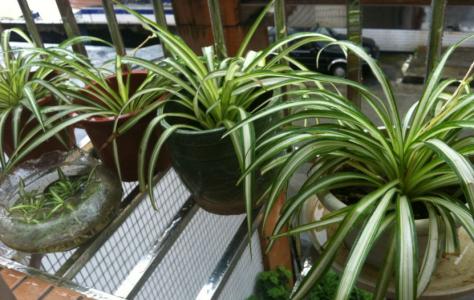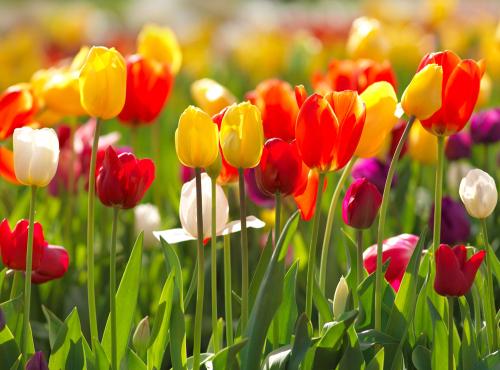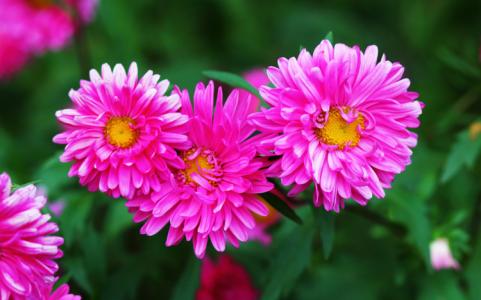Xiyin is suitable for indoor plants.
1. Hanging orchid
Cymbidium is a very common shade-loving indoor plant, which has ornamental value.

2. Evergreen
Evergreen likes water and is suitable for hydroponics. It is cyan all the year round, which is very suitable for indoor breeding.
3. Bamboo taro
Bamboo taro is a kind of plant that likes shade and water. It doesn't like sunlight very much, but it is also suitable for indoor breeding.
4. Rough rib grass
Rough rib grass is a kind of hydroponic plant, which is suitable for being placed in a dark room.
5. One-leaf orchid
One-leaf orchid is a kind of plant which is very suitable for dark and weak light environment and is easy to feed.
6. White palm
White palm likes water, suitable for water culture, can be placed in indoor culture.
Taboos on the arrangement of indoor plants
Plants can carry out photosynthesis, provide fresh air for people, reduce the radiation of various electrical appliances, adjust the aura, and make people's life full of vitality. But does anyone know which plants are suitable for growing in the house? Today, I would like to introduce the plants suitable for indoor farming and the taboos on the placement of plants.
Plants suitable for indoor farming
Plant name: silver emperor, alias: silver king bright silk grass, silver king evergreen, silver king thick rib grass.
Families and genera: Araceae, Euphorbia.
Morphological features: perennial evergreen herbs, extremely short stems, plant height 40-50 cm, leaves densely clustered, 20-25 cm long, 5-7 cm wide, lanceolate, dark green leaves, dense silver-gray patches on the leaf surface, gray-green back. Petiole with gray-green spots, petiole base sheath-shaped clasping stem.
Plant name: silver queen, alias: silver queen evergreen, silver back thick rib grass, silver queen bright silk grass.
Families and genera: Araceae, Euphorbia.
Morphological characteristics: perennial herbs. The plant height is 30-40 cm, the stem is erect and unbranched, the internodes are obvious. The leaves are alternate, the petiole is long, the base is enlarged into a sheath, the leaf is narrow and long, light green, the leaf surface has gray-green stripes, and the area is larger.
Plant name: Brazilian iron, alias: Brazilian millennium wood, Phnom Penh dragon blood tree, Brazilian wood.
Families and genera: Liliaceae, Dragon Blood Tree.
Morphological characteristics. Liliaceae evergreen trees, potted 50 cm-150 cm high, branched; leaf clusters born at stem top, 40 cm-90 cm long, 6 cm-10 cm wide, curved arched, bright green glossy; flowers small, fragrant.
Plant name: cycad, alias: iron tree, Phoenix tail banana, Phoenix tail pine, fire-avoiding banana.
Family and genus: cycads of the family Cycas.
Morphological features: evergreen palm-shaped woody plant; stem cylindrical, unbranched; stem densely covered with persistent leaf base and leaf scars, and scalelike; leaves spirally arranged, leaves arising from the top of the stem, leaves with two kinds of nutritious leaves and scale leaves, nutritious leaves pinnate, large, scale leaves short and small; leaflets linear, involute at birth, oblique backward, slightly V-shaped, margin significantly reversed downward, thick leathery, hard, shiny.
Plant name: black Beauty, alias: spring grass, loose bed.
Family and genus: Scyllaceae.
Morphological features: perennial herbs, low plants, only 5-10 cm tall. Leaves opposite, heart-shaped or broadly ovate, slightly wrinkled and curly, resembling black hair, hence the name, clumpy, dense branches and leaves are not easy to mess.
Plant name: pocket coconut, alias: dwarf coconut, pocket brown, dwarf brown.
Families and genera: pocket coconuts of palms.
Morphological features: when pocket coconut is potted, the plant height is not more than 1 meter, its stem is slender and erect, unbranched, dark green, with irregular rings on it. Leaves from the top of the stem, pinnately compound, cleft, lobes broadly lanceolate, 20-40 pinnate leaflets, sickle-shaped, dark green, shiny.
Plant name: White palm, alias: White crane taro, bract taro, peace taro.
Families and genera: Araceae, Araceae.
Morphological characteristics: perennial evergreen herbaceous foliage plants.
Plant height 40-60 cm, with short rhizomes, mostly tufted. Leaves oblong or sublanceolate, both ends acuminate, base cuneate. The flower is a Buddha bud, slightly fragrant, leaf-shaped, similar to the palm of the hand, hence the name white palm.
Plant name: green pineapple, alias: devil vine, stone citrus, bamboo leaf grass.
Families and genera: Araceae, green radish.
Morphological features: green radish vines are several meters long, often climbing on the rocks and trunks of the rainforest, with air roots at internodes. With the increase of age, the stem becomes thicker and the leaves become larger and larger, which can grow into giant lianas; a few leaves will also be slightly yellow or white mottled.
Plant name: emerald, alias: long heart leaf vine green velvet, emerald forest taro.
Families and genera: Araceae (Araceae).
Morphological features: the emerald forest taro is a trailing species, with stout stems and air roots on the nodes; the leaves are long heart-shaped, 25-35 cm long and 12-18 cm wide, with no tip, and the base is deep heart-shaped, green, entire and shiny. The tender shoots and leaf sheaths are green.
Plant name: green Emperor, alias: green Emperor Wang Xilin Taro, Emperor.
Families and genera: Araceae, Colocasia.
Morphological features: the stem internodes of the Green Emperor are short, the spacing is about 1-2 cm, the internodes are often adventitious roots, the stem diameter can reach 2-4 cm, the stem is light brown, the upright is poor; the leaves are large, clustered in rosette shape, gradually changing from yellowish green to green or dark green, shiny.
Plant name: Fugui bamboo, alias: longevity bamboo, distance flower longevity bamboo, open bamboo, rich tower, bamboo tower, tower bamboo.
Families and genera: tequila family, incense dragon blood tree genus.
Morphological features: evergreen subshrubby plants; plant height more than 1m, plant slender, erect upper branches; rhizome transverse, nodular; leaves alternate or subopposite, papery, leaves long lanceolate, with obvious 3-7 main veins, short stalked, dark green; umbels with 3-10 flowers in leaf axils or opposite to upper leaves, Corolla campanulate, purple; berries black.
Plant name: Tiger tail orchid, alias: Tiger skin orchid, brocade orchid, Phnom Penh tiger tail orchid, silver vein tiger tail orchid.
Families and genera: tequila, tiger tail orchid.
Morphological features: the underground stem is unbranched, the leaves are clustered, the lower part is cylindrical, the middle and upper parts are flat, the flag leaves are just erect, the plant height is 50 cm to 70 cm, the leaf width is 3 cm to 5 cm, the leaf is entire, and the surface is milky white, yellowish and dark green, showing transverse stripes.
Plant name: sun god, alias: dense leaf plantain, green dragon blood tree, Apollo millennium tree, dense leaf dragon blood tree.
Families and genera: tequila family, dragon blood tree genus.
Morphological features: small evergreen trees, dwarf species. Stem erect, unbranched, leaf blade densely whorled, leaf blade long elliptic lanceolate, 10-15 cm long, 2-4 cm wide, dark green.
Taboos on the display of indoor plants
1. If you have children at home, do not choose plants with thorns, such as roses, primroses, cacti, etc.
2, the home space is too small, do not choose luxuriant plants. Such as wealth tree, tortoise back bamboo and so on.
3. Plants with strong fragrance should not be put in the bedroom. If you hear it for a long time, you will have a dry mouth and sore throat.
4. Hydroponic plants, bonsai and flower arrangement should pay attention to the change of water quality. Dirty water breeds bacteria.
5. Poisonous plants are not easy to be put in restaurants, kitchens and children's rooms.
6. Pay attention to the various properties of plants, such as yin, yang, drought and cold tolerance, etc., and place them selectively.
7. Pay attention to whether your family is allergic to pollen and carefully choose plants with too much pollen. Such as lilies, roses, etc.
8, do not completely count on plants to absorb harmful gases such as formaldehyde, the effect is limited.
Green plants in the bedroom
Plants do not purify the air all the time. When there is no sunlight, plants will spit out carbon dioxide and absorb oxygen. So don't put broadleaf plants in the bedroom. Such as: tortoise back bamboo, rich tree, green apple and so on.
In addition, the aroma of plants is used to attract insects to pollinate, so the aroma will be mixed with some biological substances, which can make people anxious, dizzy, difficult to breathe and so on. It's not easy to put it in the bedroom. Such as tulips, roses, lilies, nocturnal incense, etc. You can put some smaller bonsai or aquatic plants. Such as: Tiger Pilan and so on.
Green plants in the living room
The arrangement of plants in the living room can follow the principles of simplicity, nature, arbitrariness and attention to fengshui. The living room is the main space to appreciate plants, but do not put too much, too dense, noisy guests.
The asparagus on the bookshelf, the lily on the TV cabinet and the hanging orchid on the wine cabinet seem to be inadvertently arranged, but they have a masterstroke.
Living room plants should pay attention to maintenance, often trimmed. Dilapidated leaves or withered flowers can make people sad and bring bad mood.
The plants in the living room are generally placed in the corridors, the corner of the stairs and the entrance to the gate. Or on the windowsill, cupboard, table. Often put plants are: chrysanthemum, kumquat, daffodils, rich bamboo, orchids and so on. Oleander, tulips and other poisonous plants are recommended to be placed indoors or outdoors with good ventilation.
Green plants in kitchens and dining rooms
The kitchen and dining room are easy to put plants with warm flowers such as orange and yellow to increase appetite and regulate mood. Generally, flower arrangement is the main method. Such as Fran, carnations, all kinds of orchids, chrysanthemums and so on. In addition, the orchid has the characteristic of absorbing lampblack, which can be placed in the kitchen.
The arrangement of green plants in the study
The study is a quiet space, should be dominated by green leaf plants, not easy to place too gorgeous or fragrant flowers.
Plants commonly used in the study, such as: evergreen, asparagus, tortoise back bamboo, dripping Guanyin, ornamental bamboo, Reed, or all kinds of bonsai.
The above are the plants suitable for indoor farming and taboos for indoor plants to be shared with you. I hope it will be helpful to you.
Introduction to the growth habits and culture methods of bird's nest fern, a shade-loving plant
The bird's nest fern, also known as nest fern, mountain perennial fern, crown fern, etc., is a perennial herbaceous foliage plant of the family Pteridaceae. It has high ornamental value and is suspended indoors. It is planted under tropical garden trees or rockery rocks. Potted small plants are used to decorate bright living rooms, conference rooms, study and bedrooms. Let's take a look at the breeding methods and matters needing attention of bird's nest ferns.
Growth habits of bird's nest fern
Bird's nest ferns are distributed in many tropical areas and are attached to tree trunks, rock walls and other places. The base accumulates the fallen leaves of many other tree species and is shaped like a bird's nest, hence the name. The rhizome of the bird's nest fern is short and thick, and the marginal leaves are clustered from the underground stems and are nesting from the central direction. Like high temperature, not resistant to strong light, especially like to attach to the Yulin or seasonal rain forest tree trunks or rocks under the forest.
Breeding methods of bird's nest fern
1. Sowing: first mix the fine sand and humus soil well in spring, disinfect at high temperature, put it into the sowing basin and flatten it, spread the mature spores evenly on the basin soil, then soak the basin soil in shallow water, make the basin soil fully moist, cover the glass to moisturize, and put it in a warm and cool place, the spores can germinate in 7 to 10 days, and the green original leaves will grow after about a month. It can not be cultivated in the pot until a few true leaves grow out after 3 months.
2. Ramet: the ramet propagation of bird's nest fern is generally carried out in the middle and late April. Select the strong growing plant, cut its rhizome together with leaves and root clusters into several pieces, or cut off the small plant, cut off the leaf, put it on the pot, and cover it with a small amount of rotten leaf soil, so as to create a humid, ventilated and well-drained environment. The environmental temperature is controlled at about 25 ℃, and the survival rate is high. Pay attention to the pot soil should not be too wet, so as not to cause rotten roots.
The culture method of bird's nest fern
1. Temperature: whether it is domestic pot cultivation or productive cultivation, it is best to maintain a greenhouse temperature of more than 15 ℃ in winter so that it can continue to grow. when the conditions are not available, it should at least maintain a greenhouse temperature of not less than 5 ℃. If the temperature is too low, the leaf margin will turn brown, and even the plant may die due to cold injury.
2. Lighting: the original environment of bird's nest fern is moist jungle, which is mostly attached to ecology, and can grow normally with a small amount of scattered light, so potted plants can be preserved in bright indoor light all the year round. Such as spring and autumn short-term placed in the shade of outdoor trees or in the greenhouse, it is more conducive to its growth, and can increase the luster of the leaves.
3. Moisture: the bird's nest fern should be fully watered in the growing season, especially in summer, in addition to the cultivation substrate should be often watered, the foliage must be washed 2 to 3 times a day, and the surrounding ground should be sprinkled to humidify, so as to maintain a high air humidity in the local environment, which can not only increase the gloss of the leaf surface, but also is very beneficial to the germination of spore leaves.
4. Soil: the potted substrate of bird's nest fern can be mainly composed of rotten leaf soil, peat soil and vermiculite, mixed with a small amount of river sand, or mixed with fern root, broken bark, moss or broken brick particles and a small amount of humic soil. In addition, a little crushed lime can be added to the basin every spring, which is beneficial to the growth and development of its parasperm.
5. Fertilizer: the bird's nest fern is potted in its vigorous growth season. It is advisable to apply a balanced thin fertilizer of nitrogen, phosphorus and potassium once a month, which can promote it to grow a large number of new leaves. If the plant is short of fertilizer, the leaf edge will turn brown. If the summer temperature is higher than 32 ℃ and the greenhouse temperature is lower than 15 ℃ in winter, all forms of topdressing should be stopped.
Points for attention of bird's nest fern
1. Bird's nest fern is suitable to grow in peat soil or rotten leaf soil, and the suitable temperature for bird's nest fern growth is 22-27 ℃.
2. Under the condition of high temperature and humidity in summer, the growth of new leaves needs more water to maintain the humidity of the air.
3. The breeding of bird's nest fern does not need much sunlight, but only a small amount of scattered light can grow normally.
4. The growing season of bird's nest fern should be fully watered, and the basin soil should be kept moist when the room temperature is low in winter.
- Prev

Plants that are not suitable for breeding indoors
1, easy to cause allergic plants this type of plants have a magenta, a string of red, jade cloves, five-colored plum, bauhinia and so on, touch them will cause skin allergic reaction. Poisonous plants like this type of plants include mimosa, yellow and white azaleas, Yu Mei and evergreen, etc.
- Next

Maintenance measures of Dutch Chrysanthemum
1. Light management Dutch chrysanthemum likes an environment with plenty of light and good ventilation, so make sure there is plenty of sunshine. 2. Watering management the Dutch chrysanthemum should be watered appropriately, according to the dry soil, and remember that there should be no stagnant water. 3. Soil management: choose soil with loose soil and good drainage and permeability.
Related
- Fuxing push coffee new agricultural production and marketing class: lack of small-scale processing plants
- Jujube rice field leisure farm deep ploughing Yilan for five years to create a space for organic food and play
- Nongyu Farm-A trial of organic papaya for brave women with advanced technology
- Four points for attention in the prevention and control of diseases and insect pests of edible fungi
- How to add nutrient solution to Edible Fungi
- Is there any good way to control edible fungus mites?
- Open Inoculation Technology of Edible Fungi
- Is there any clever way to use fertilizer for edible fungus in winter?
- What agents are used to kill the pathogens of edible fungi in the mushroom shed?
- Rapid drying of Edible Fungi

